I am patiently waiting for a chance to see one of the Old World’s great scavengers of the air, such as the Griffon vulture, or perhaps even the mighty Lammergeier. But in the mean time it was the New World vultures of the United States that provided me with my first encounter with these avian angels of death. I discovered that it is a common sight to see the shadows of Turkey Vultures dancing across the great American highways.
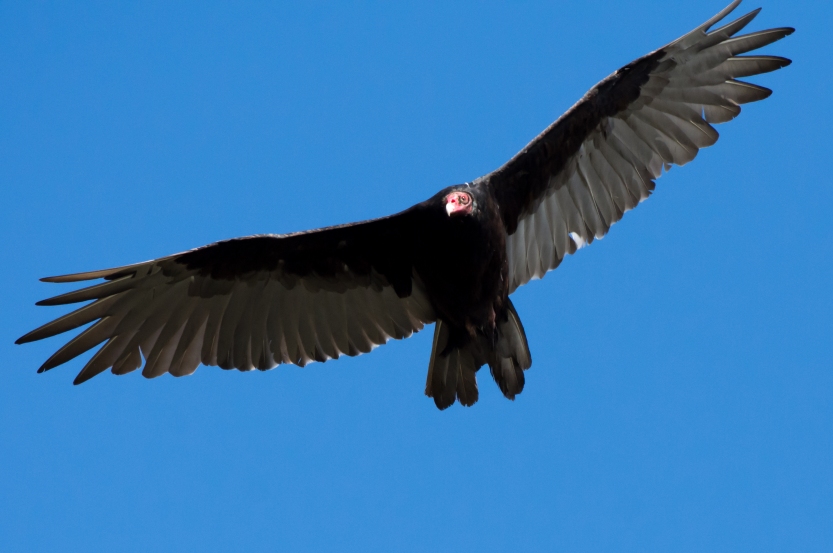
The Turkey vulture is a relatively large bird with a wingspan of approximately 70 inches (1.7 meters) and a total length of up to 32 inches (81 cm). It appears black from a distance but when one gets close to them on the ground it can be seen that they are actually dark brown. The small, turkey style, featherless red head that gives the bird its name, completes its sinister apparel.

The Turkey vulture is one of two species of New World vulture in North America, with the other being the Black Vulture. Identification is easiest when the birds are on the ground. The Black vulture has a black/grey head and darker plumage. In the air it is perhaps more challenging to tell the species apart, but I have a simple method. The Black vulture has black undersides to its wings with 6 large white primary feathers, or fingers that give an appearance of white wing tips. I look for the black ‘T’ of the Turkey vulture using the body and tops of the wings that form a ‘T’ shape, with the rest of the underwing being pale. The Turkey vulture also glides with its wings angled slightly upwards giving a ‘V’ shape. This helps keep the bird balanced in flight when riding the rising air currents. So look for the ‘T’ wings in a ‘V’ shape and there you have a Turkey Vulture!

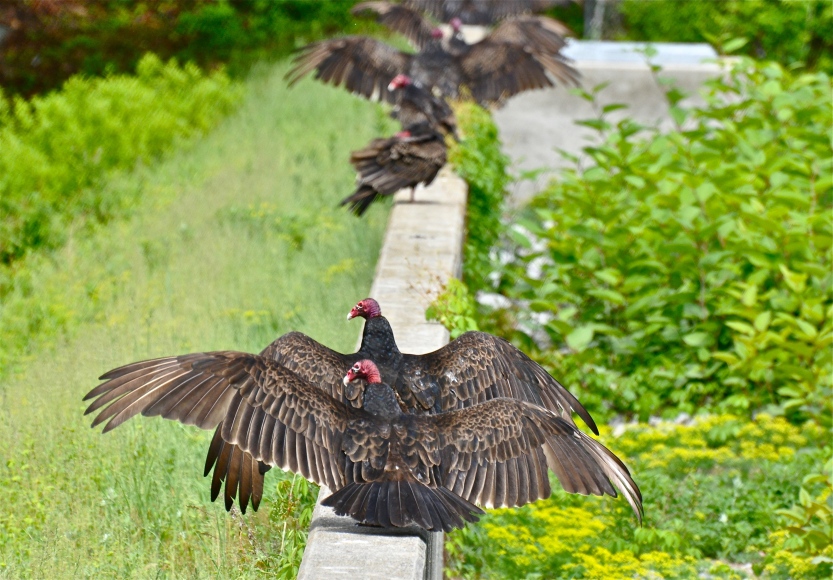
There is very little that is pleasant about vultures. Bare headed devils that are never far from death. But is this raptor really an angel of death, or is it a little unfairly maligned? Turkey vultures feed primarily on carrion. They are also happy to clear up the waste left by human excess. The roadside is a valuable feeding ground for them. With a keen sense of smell, which is unusual in birds and missing from the Black vulture, the Turkey vulture helps clear the land of carcasses and decay. The bird has a unique nostril design, sensitive to decay down to Parts Per Billion (PPB) that allows it to detect a mouse corpse beneath leaf litter, under the forest canopy. They can smell a decay up to eight miles away when they are 1000 feet in the air.
If you’re going to spend your life eating rotten meat then you need to think about personal hygiene. These birds have some habits and adaptations that help keep them in tip-top condition:
- An excellent immune system
- A featherless head which helps it stay clean as it inserts into places that heads should not go.
- A nostril cover plate prevents rotten meat lodging in those super-sensitive nostrils. They also pick their nose with a long hooked toe nail in order to keep it clear of rotten meat.
- A grooming habit that has them spend time cleaning themselves and each other.
- Perhaps my favourite, and the most spectacular, is the habit of sitting with back to the sun, allowing the UV rays to decontaminate those huge wings from any parasites or bacteria of decay.
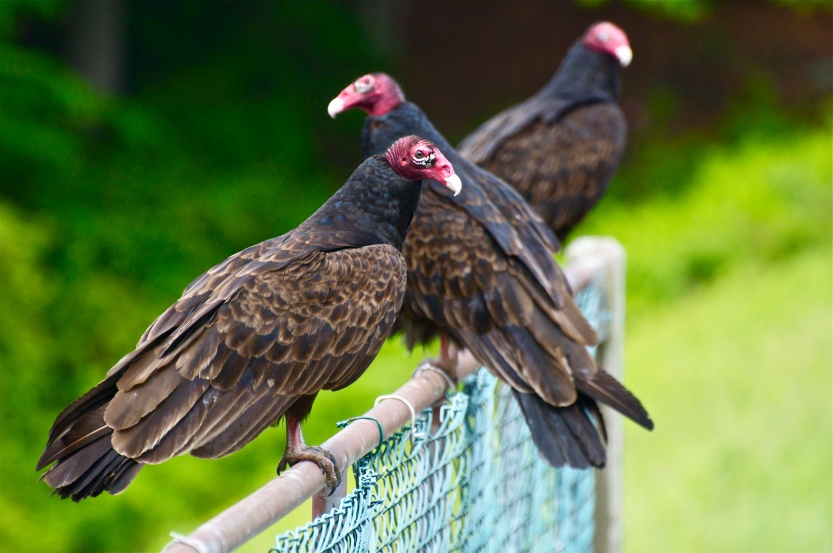
I’ve encountered Turkey vultures in most areas of the US that I have visited. My first close encounter was in Upstate New York. I had only seen the vultures whirling above my head, until I spotted a small committee of them perched along a wall and fence bordering a reservoir. I sprang out of the car, grabbed my camera and was able to fire off a few shots.
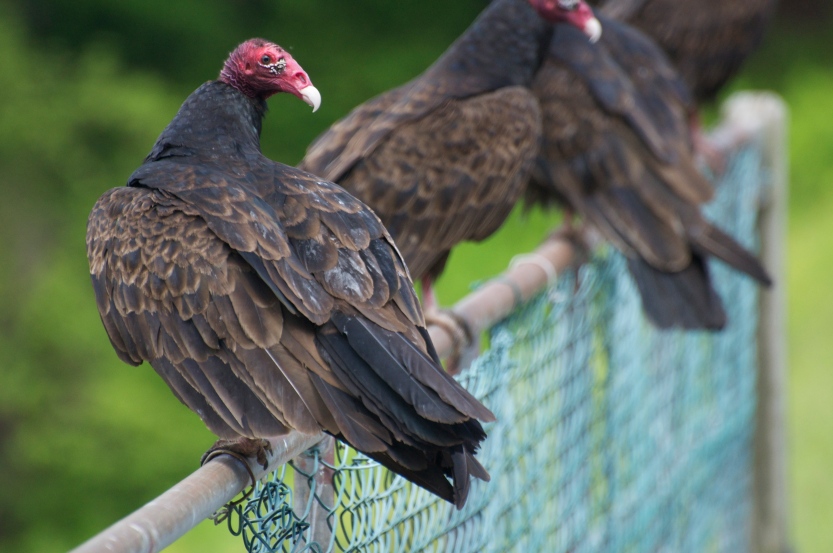
My next significant vulture encounter was in Campbell River on Vancouver Island. Here I found vultures sat in the tree-tops sunning themselves, occasionally dropping away into a low glide, in search of salmon corpses left over from the spawning season, or the remains left over from a Black bear’s fishing trip. This was a wonderful opportunity to get close to these birds during take-off and landing which gave a true sense of the size of these great birds.
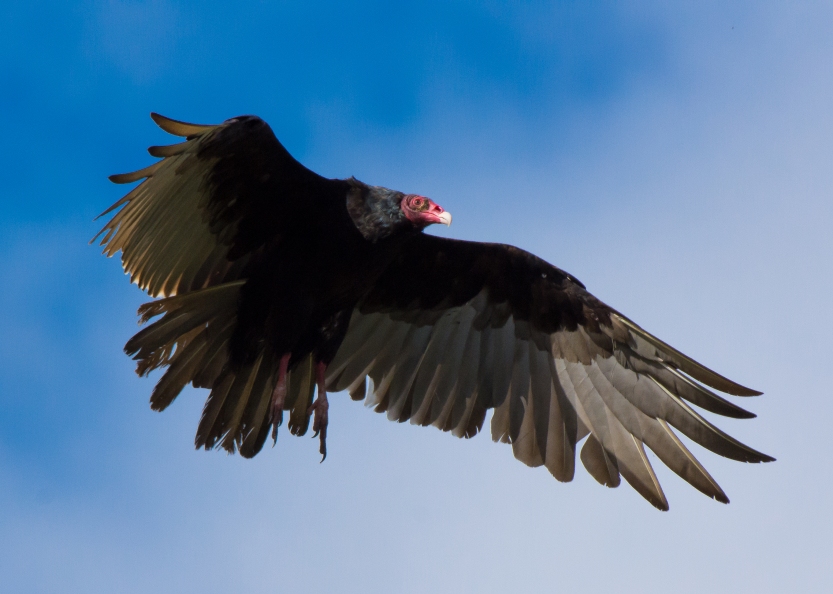
A little known fact about Turkey vultures is that they have been known to collide with airplanes. Between the years 1989 and 1992 US Air Force records show Turkey Vulture collisions with aircraft resulted in two human deaths, three airplane crashes, and a loss of more than 21 million dollars. Let’s not forget the poor vulture who was probably the one who was collided with.
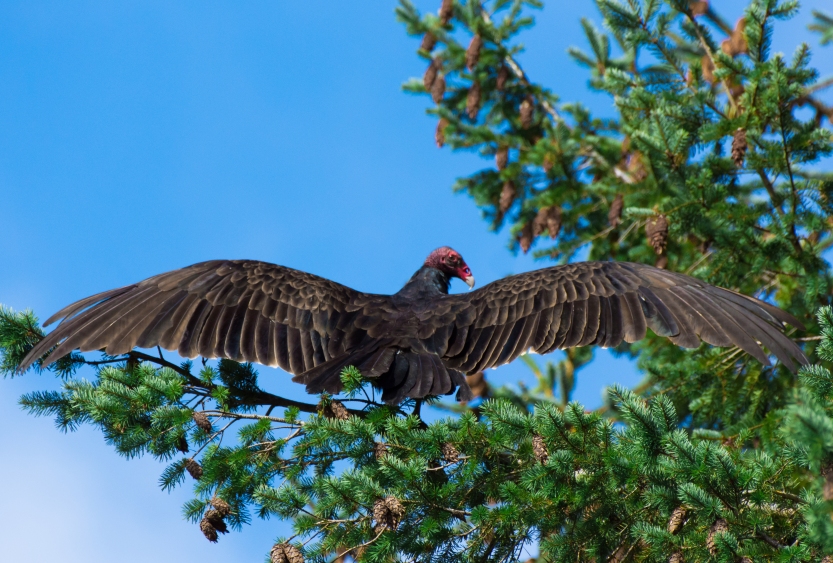
This amazing bird with the super-power of smell carries out an essential role in nature. It is unfortunate that the creatures that carry out these grizzly task are often the creatures that we abhor. Turkey vultures are out there cleaning the land, reducing the spread of disease and distributing recycled nutrients. I’m always happy to see them wheeling high in the sky above, waiting for the next opportunity to clear our roadsides of the dead.
If you enjoyed this post, please follow Incidental Naturalist.
Comments below are welcomed.
Help others to connect with wildlife experiences by sharing this post on social media.
Categories: USA
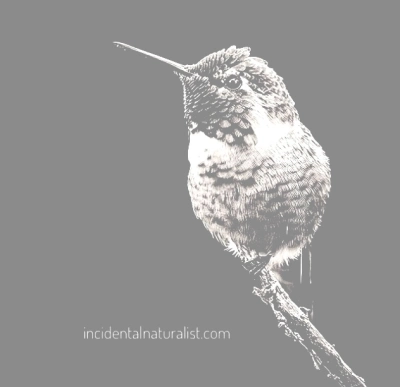


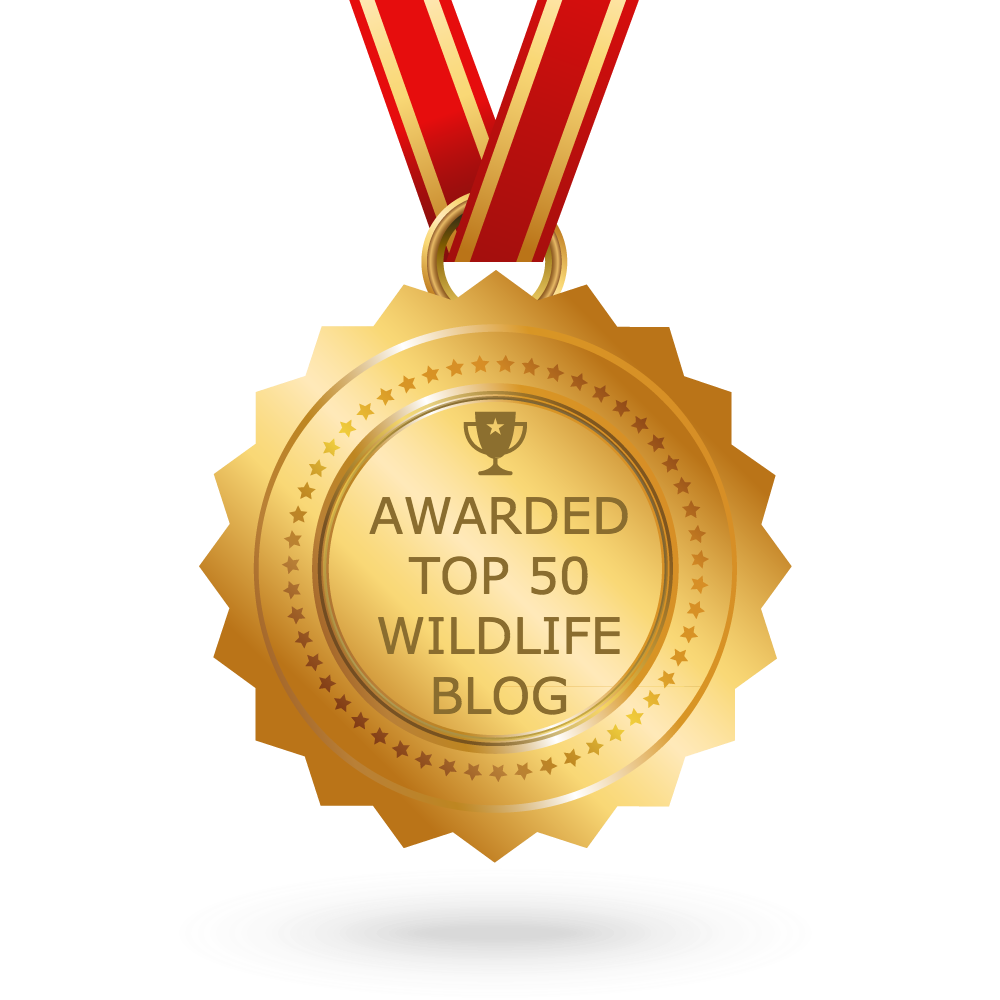

Nice photos
LikeLiked by 1 person
Good post. At times needed I feed the vultures scrapes of meat (that I get free) from local butchers. You called this article Angels of Death but did not mention it in your article. I would like to hear from you about Angels of Death quote. My E mail is
Arline@Bobatisafarm.com. I truly appreciate your article and hope to hear from you. I like the the quote very much, warms my heart. Thanks again.
Arline Soffian
Arline@Bobatisafarm.com
5850 Lower Mountain Road
New Hope, Pa. 18938
215-794-7794 land line
LikeLike
Great post, David! I see turkey vultures practically everywhere I go in the US, and they are indeed valuable animals. They definitely deserve respect.
LikeLiked by 2 people
Thanks Josh! Good to hear from you. They are one of those creatures that somewhat benefits from the trail of disaster that humans leave behind. I never get tired of seeing them whirling in the skies above me.
LikeLiked by 2 people
Thank you for the valuable information you have shared. Great photos
LikeLiked by 2 people
Thanks for your kind comment!
LikeLiked by 1 person
What a face! I admire your ability to take such great air shots. We don’t have any kind of vultures in Australia, but I guess our wedgetail eagles do a similar job when they feast on road kills. I am yet to photograph them though. Great to see your return to blogging, David. Best wishes, Jane.
LikeLiked by 2 people
Thanks Jane! I do delete more flight photos than I keep. 😊 I would have loved to get a wedgetail photo. I always got that skipped heart beat when I saw those glorious birds above.
LikeLiked by 2 people
Great post, David! Love to learn about parts of nature we often overlook as not obviously “cute” or less aesthetically pleasing to us somehow. Wonderful how nature creates balance in all – these birds have such an important job. Excellent reminder that there is an intricate chain going on, and we’re both a part of it and a major impact upon it when we meddle without considering the whole.
LikeLiked by 2 people
Thanks for the great comment, Lara! It is very easy to forget that we are the eco-system and that all parts of that system are connected with a very fine balance. It is also important to remember that as part of that system, not everything we do is bad, as we often believe. It just is!
LikeLiked by 2 people
Wonderfully said, David! Need to look at the whole and how it all interplays versus taking one piece out and making judgments on. Very analogous to much in life “) Great lessons – thank you!
LikeLiked by 1 person
Love these guys, but I have to tell you, on a long, hot bicycle ride, when I am near the end of my rope, it is a bit disconcerting to see them circling above my head as I ride!
Great write up, I learned a lot!
LikeLiked by 1 person
😂 great comment! I can see how that might be a little unsettling. They know when someone is in trouble! Thanks for your kind words!
LikeLiked by 1 person
Really enjoyed reading about turkey vultures. Very well written blog post. Will continue to follow you.
LikeLiked by 1 person
Thank you for your kind words! Welcome to my blog, I’m very happy to have you as a follower. David
LikeLike
Great article as always, David! And happy to see some light shed on these much-maligned birds. They are amazingly adapted to their role in our world and a necessary part of our wild ecosystem. Vultures clean things up as you mentioned and actually halt the spread of disease. I love to watch them riding the thermals at incredible heights. On the ground, they are big and gawky. They like to eat one-at-a-time in a pretty strictly enforced hierarchy, they sometimes groom each other and are funny when they are parading around and posturing in the sun.
LikeLiked by 1 person
Thanks Roberta! I love that you usually add a little extra to the conversation with some additional facts. I was surprised to find that hierarchy goes out the window when the Black vultures arrive as they are more aggressive. They are wonderful to watch riding the thermals. The way they rock in that “V” shape. Thanks again, and happy holidays to you and yours.
LikeLike
I enjoyed this informative and interesting post about the American vultures, David, and your photos were a pleasure.
LikeLiked by 1 person
Turkey Vultures are birds I have witnessed in the Midwest skies most of my life. I have always preferred to think of them as the avian ecological clean-up crew. Love to see them lazily circling on thermals!
LikeLiked by 1 person
I love it! Avian ecological clean-up crew! That sounds great! 😄👍🏻
LikeLike
Wow. Never heard of a turkey vulture and not sure if I’ve seen one. Will have to look closely next time I’m out 🙂
LikeLiked by 1 person
I’ve seen many turkey vultures over the years and had a vague awareness of their importance. After reading this, I will have more respect and appreciation for them. Their adaptations are particularly interesting.
LikeLiked by 1 person
Thanks for taking the time to comment, JoAnna. I’m really pleased that you’ve taken something positive out of this post 😊
LikeLiked by 1 person
Impressive images, David. Wow, what an impressive sense of smell even when they fly that high!!
LikeLiked by 1 person
Thanks for the kind words Indah, and thanks for following! 🙂
LikeLike
Thanks for the great pics! I love turkey vultures. They are such acrobatic flyers. I do believe that they really just enjoy flying, not doing it just to find food. (sort of like the theme of Jonathan Livingston Seagull, if you remember that one)
LikeLiked by 1 person
Thanks for the kind words! They are incredible flyers and I’m certain that they are happiest on the wing. I haven’t read that book, but maybe now I will. Thanks!
LikeLiked by 1 person
Hi David,
Nice shots and post, I learned a few things. Out here in central coastal CA, TVs are a daily sight. In fact there us a tall eucalyptus tree by my post office where they all come to roost. You can imagine what the sidewalk looks like beneath it. If you have a chance I would love to get your feedback on my blog, trackandseek.org. I just started recently and am still figuring wordpress out.
Cheers,
Bart
LikeLiked by 2 people
Thanks for the kind words, Bart! I always think there is something a little sinister about vultures roosting above us. Almost as though they know something we don’t 😄 I stopped by your site. It looks fascinating! Looking forward to following.
LikeLiked by 1 person
loved the article and the part that justifies (although not necessary) the part that these birds play in the ecosystem.
LikeLiked by 2 people
Thanks for the kind comment. The vulture needs a bit of recognition. It’s a tough job!
LikeLiked by 1 person
Great post, pictures, and information. Goes well with your post on hummingbirds. At 70 I have become an avid birder after years of hunting (in youth), fishing, and hiking. Recently, I was in South Texas and saw several Crested Caracara. (Mexican Eagle). They are native to Mexico — not much in US, I think, but I saw several a few miles from the border. The fit nicely with the Turkey and Black vultures — carrion eaters. I cannot distinguish vultures in flight as you can. I think I can distinguish when they are earth bound. I have much to learn and look forward to other posts and pictures.
LikeLiked by 1 person
Thank you, Larry! I’m happy that you enjoyed the post. The path from hunting and fishing to birdwatching is a well trodden one. 😊 That is great that you got to see the Crested caracara. I am yet to get a good sighting of those splendid birds. I saw the Yellow-headed caracara in Panama last year. If you follow my guide in the post I guarantee that you will soon find it easier to identify Turkey and Black Vultures in the air than on the ground.
LikeLike
Great article I have learnt a bit more about vultures.
LikeLiked by 1 person
I am a turkey vulture fan!!!! My spirit animal, such beautiful creatures. God knew what he was doing in creating these majestic birds that most people hate but I revere
LikeLiked by 1 person
They are majestic and such important cogs is the machine of life. Thanks for stopping by and taking the time to comment.
LikeLike
I was thrilled to read you article above, I have special experiences with the vultures. I have learned their interactions with each other and their pecking order.I think the black vulture is a beautiful bird in all aspects and their behavior, dancing, gliding, mannerism, cleanliness, etc. I have been fortunate to interact with them. Actually three only because of pecking order. I hope you see this post, if so would you let me know.
Thanks much for writing this article.
Arline Soffian
Arline@Bobatisafarm.com
LikeLiked by 1 person
Hi Arline, thanks for stopping by and taking the time to comment. Always good to meet another vulture enthusiast. I was recently in south New Jersey as the Black and Turkey vultures passed over for their Fall migration. Magnificent to watch large groups circling high above.
LikeLike